Biology > GCSE MARK SCHEME > GCE Biology A H420/03: Unified biology Advanced GCE Mark Scheme for Autumn 2021 (All)
GCE Biology A H420/03: Unified biology Advanced GCE Mark Scheme for Autumn 2021
Document Content and Description Below
GCE Biology A H420/03: Unified biology Advanced GCE Mark Scheme for Autumn 2021 Oxford Cambridge and RSA Examinations GCE Biology A H420/03: Unified biology Advanced GCE Mark Scheme for Autumn 2... 021Oxford Cambridge and RSA Examinations OCR (Oxford Cambridge and RSA) is a leading UK awarding body, providing a wide range of qualifications to meet the needs of candidates of all ages and abilities. OCR qualifications include AS/A Levels, Diplomas, GCSEs, Cambridge Nationals, Cambridge Technicals, Functional Skills, Key Skills, Entry Level qualifications, NVQs and vocational qualifications in areas such as IT, business, languages, teaching/training, administration and secretarial skills. It is also responsible for developing new specifications to meet national requirements and the needs of students and teachers. OCR is a not-for-profit organisation; any surplus made is invested back into the establishment to help towards the development of qualifications and support, which keep pace with the changing needs of today’s society. This mark scheme is published as an aid to teachers and students, to indicate the requirements of the examination. It shows the basis on which marks were awarded by examiners. It does not indicate the details of the discussions which took place at an examiners’ meeting before marking commenced. All examiners are instructed that alternative correct answers and unexpected approaches in candidates’ scripts must be given marks that fairly reflect the relevant knowledge and skills demonstrated. Mark schemes should be read in conjunction with the published question papers and the report on the examination. © OCR 2021H420/03 Mark Scheme October 2021 Annotations Annotation Meaning DO NOT ALLOW Answers which are not worthy of credit IGNORE Statements which are irrelevant ALLOW Answers that can beaccepted ( ) Words which are not essential to gain credit Underlined words must be present in answer to scorea mark ECF Error carried forward AW Alternative wording ORA Or reverse argumentH420/03 Mark Scheme October 2021H420/03 Mark Scheme October 2021 7 Question Answer Marks AO element Guidance 1 a (A =) spiracle (B =) trachea 2 2.3 ALLOW spiracles DO NOT ALLOW tracheoles ALLOW chitin (rings) / taenidia / tracheal tube / tracheae b i All 4 columns correct 2 1.2 3 columns correct = ii remove operculum / described (rather than cutting up the ventral side) use pins to hold fish (rather than a hand) remove gills and observeunder a microscope 1 max 3.3 IGNORE ‘removegills’ unqualified IGNORE ‘use a microscope’ unqualified c i 60 (cm3) 1 2.2 1.44 dm3 = 1440 cm3 1440 / 24 = 60 ii inbreeding / AW, reduces genetic diversity (more) homozygous recessivealleles (forCPF) idea of allele forCPF linked to gene fordesirabletrait (so inherited together) 1 max 2.5 ALLOW ‘inbreeding creates smaller gene pool’ ALLOW ‘more homozygous recessive genotypes (for CPF)’ ALLOW (leads to) inbreeding depression e.g. ‘CPF gene on same chromosomeas (named) desirable trait ‘ Mouth closes Buccal cavity floor lowers Operculum opens Oxygen diffuses into capillaries Water moves into the buccal cavity Water moves across the gills and out of the buccal cavity H420/03 Mark Scheme October 2021 10 Question Answer Marks AO element Guidance iii idea of comparegenomes of, dog breeds / individual dogs idea of identify, alleles / genotypes / basesequences (in WHTs), that are present (only) in dogs with CPF idea of identify dogs that are carrying (the allele for) CPF (use of)computational biology / bioinformatics,to link genes with CPF idea of linking DNA sequences to specific proteins (i.e. proteomics) 2 max 2.5 e.g. ‘compareDNA of dogs withand without CPF’ e.g. ‘identify, allele/ gene, that causes CPF’ e.g. ‘can identify mutated proteinfrom DNA sequence’ iv weakened / dead / inactivated, (parvo)virus antigens from the(parvo)virus mRNA to produce(parvo)virus proteins 1 max 2.1 IGNORE ‘dormant form of virus’ ALLOW ‘attenuated form of virus’ ALLOW viral coat proteins v memory cells have, reduced in number / AW 1 2.5 ALLOW to producemorememory cells (to improve immunity) DO NOT ALLOW ‘no memory cells left’H420/03 Mark Scheme October 2021 11 Question Answer Marks AO element Guidance 2 a Please refer to the marking instructions on page 4 of this mark scheme for guidance on how to mark this question. In summary: Read through the whole answer. (Be prepared to recognise and credit unexpected approaches where they show relevance.) Using a ‘best-fit’ approach based on the science content of the answer, first decide which of the level descriptors, Level 1, Level 2 or Level 3, best describes the overall quality of the answer. Then, award the higher or lower mark within the level, according to the Communication Statement (shown in italics): o award the higher mark where the Communication Statement has been met. o award the lower mark where aspects of the Communication Statement have been missed. • The science content determines the level. • The Communication Statement determines the mark within a level. Level 3 (5-6 marks) Describes in detail, with no major errors, the stages of mitosis inall three cells. There is a well-developed line of reasoning which is clear and logically structured. The information presented is relevant and substantiated. Level 2 (3-4 marks) Describes, withfew errors or omissions, thestages of mitosis inall three cells. OR Describes in detail, with no major errors, at least two cells. There is a line of reasoning presented with some structure. The information presented is relevant and supported by some evidence. Level 1 (1-2 marks) Describes the stages of mitosis, withsomeerrors, in at least one cell. OR Describes stages of mitosiswithno link to cells in question 6 2.5 2.7 Indicative scientific points (including details in bold) may include (but are not limited to): Cell C: • Prophase • Chromosomes condense • Chromosomes have become visible (but are unordered) • Nuclear envelopeand nucleolus have disappeared Cell D: • (Early) anaphase • Spindlefibres are shortening • Chromatids are separating and are being pulled to opposite sides of the cellH420/03 Mark Scheme October 2021 12 Question Answer Marks AO element Guidance There is an attempt at a logical structure with a line of reasoning. The information is in the most part relevant. 0 marks No responseor no responseworthy of credit. Cell E: • (Late) telophase • Chromatids have been pulled to opposite sides of the cell • A new cell membrane is visible down the centre of the cell • Cytokinesis/ thecell is beginning to divide b i idea that (some) cells containincorrect number of chromosomes 1 3.1 e.g. cells do not contain the diploid number of chromosomes / cells contain different numbers of chromosomes ii G1 (checkpoint)AND idea that cells (with damaged DNA) should be stopped from entering the S phase G1(checkpoint)AND idea that this is the point where DNA damage is checked 1 3.1 DO NOT ALLOW G2 (as if this was not working bothreplicationand mitosis would occur) c Binary fission has chromosome(s) do not condense prior to separation no lining up of chromosomes, inpairs / across equator no separation of chromosomes into chromatids chromatids not joined at centromere no, centrioles / spindle fibres one large chromosomerather than several smaller chromosomes (replicationof)circular DNA / plasmid(s) 2 max 2.5 Mark as continuous prose ALLOW ora throughout IGNORE ref to nuclear membrane disappears ALLOW ‘no lining up of DNA across equator’ ALLOW ‘no separation of chromatids’ DO NOT ALLOW ‘no chromosomes being pulled to opposite sides of cell’H420/03 Mark Scheme October 2021 13 Question Answer Marks AO element Guidance d i ‘For’ statement: no lag phase (is shown) no (clear), stationary / death / decline, phase idea that decrease between day 3 and 4 is not typical of standard growth curve ‘Against’ statement: idea that lag phase may bepresent but day 0 data are not shown exponential / log / rapid growth, phasepresent (between day 1 and 2) idea that stationary / death / decline, phase may occurlater General point: idea that presence of limited nitrate is responsiblefor the (non-standard) growth curve 4 max 3.1 ALLOW clear descriptions of stages of growthcurve e.g ‘there is no fall in number of cells at end of growth curve’ e.g. ‘lag phase may occurbetween day 0 and day1’ ALLOW ‘growthrate increases (between days1-5) but then rate of growth slows down’ e.g. ‘reductionin nitrate could lead to fall in cell numbers between day 3 and 4’ / ‘as nitrate levels fall bacterial cell numbers are still increasing’H420/03 Mark Scheme October 2021 14 Question Answer Marks AO element Guidance ii FIRST CHECK ON ANSWER LINE If answer = 2.5 x 106 award 3 marks 104.7 = 50,118.72336 x 50 (= 2,505,936.168) standard form = 2.5 x 106 3 2.4 ALLOW any value between 104.5 and 104.8 i.e. 1.6 - 3.2 x 106 award 3 marks ALLOW 31,622.7766 – 63,095.73445 ALLOW any correct rounded value This mark should be awarded to ‘x50’ seen anywhere in the working, regardless of the value being multiplied This mark should be awarded for correctly converting to standard form, regardless of the value being converted as ECF MAX 2 for correct answer not converted to standard form iii serial dilution idea of grow colonies (onagar plate) and count number of colonies idea of scale up /multiply up, count (to estimate populationsize) 2 max 2.7 ALLOW idea of flowcytometry / described e Short /AW pollutants / contaminants metabolites 3 1.1 ALLOW pollution / contamination / waste / oil /solvents /pesticides / benzene / plastics / chemicals IGNORE impurities / faeces / toxins / bacteria / pathogens 3 a callose… (has) 1-3 and 1-6 glycosidicbonds (is) branched (is) helical idea of alternate glucose molecules are not rotated 180° 2 max 2.1 ALLOW cellulose(has only)1-4 glycosidic bonds ALLOW celluloseis, not branched / straight chains ALLOW cellulose is not helical IGNORE callose is more compact ALLOW idea of alternate glucose molecules rotated 180° in celluloseH420/03 Mark Scheme October 2021 15 Question Answer Marks AO element Guidance b Please refer to the marking instructions on page 4 of this mark scheme for guidance on how to mark this question. In summary: Read through the whole answer. (Be prepared to recognise and credit unexpected approaches where they show relevance.) Using a ‘best-fit’ approach based on the science content of the answer, first decide which of the level descriptors, Level 1, Level 2 or Level 3, best describes the overall quality of the answer. Then, award the higher or lower mark within the level, according to the Communication Statement (shown in italics): o award the higher mark where the Communication Statement has been met. o award the lower mark where aspects of the Communication Statement have been missed. • The science content determines the level. • The Communication Statement determines the mark within a level. Level 3 (5-6 marks) A valid plan for testing the effect of temperature on callose production, including details of control variables and somedetails of callose measurement. There is a well-developed line of reasoning which is clear and logically structured. The information presented is relevant and substantiated. Level 2 (3-4 marks) A valid plan, with some details, for testing the effect of temperature oncalloseproduction, including either details of control variables or some details of callose measurement. There is a line of reasoning presented with some structure. The information presented is relevant and supported by some evidence. Level 1 (1-2 marks) A planthat mentions observing calloseproductionor controlling variables. 3.3 3.4 Indicative scientific points may include (but are not limited to): General experimental details to improve validity: • a suitablerange of temperatures (e.g. 0, 10, 20, 30, 40° C) • a suitable samplesize orthe idea of repeats (e.g. 50 plants) • idea of abaseline measure of callose levels before the experiment Control variables: • same species / size / genetics of plant (e.g. using cloned plants) • light intensity and duration (e.g. 12 hours of light and 12 hours of dark)H420/03 Mark Scheme October 2021 16 Question Answer Marks AO element Guidance There is an attempt at a logical structure with a line of reasoning. The information is in the most part relevant. 0 marks No responseor no responseworthy of credit. • pH / nutrients / water regime (e.g. using the same soil and water supply) • maintaining aseptic conditions and monitoring infections (and removing infected plants from the experiment) Callose observation: • use a microscope • take tissuesamples • standardisethe size and locationof tissue samples • take samples from different sites • use of stain(e.g. aniline blue) • immunofluorescenceH420/03 Mark Scheme October 2021 17 Question Answer Marks AO element Guidance c One mark per correct row; all correct = 3 1.1 ACCEPT any other correct examples of viral diseases in plants d example of chemical defence example of physical defence 1 max 1.1 e.g. (productionof)pheromones / poisons/ toxic compounds / named examples (phenols, tannins, alkaloids, Bt toxin) e.g. folding inresponseto touch/ thorns/ spines e insects (may) develop resistance 1 2.1 ALLOW ‘insects becomeresistant’ DO NOT ALLOW references to immunity DO NOT ALLOW insecticides cause mutations leading to resistance 4 a (carry out)Benedict’s test / described (if test forreducing sugar negative) boil with (dilute) HCl and (re)test (with Benedict’s) 2 2.7 ALLOW ‘add Benedict’s (solution)’ Type of pathogen Pathogen has membranebound organelles Pathogen has cell wall Example of a disease affecting plants fungus yes yes black sigatoka bacterium no yes ring rot virus no no tobacco mosaic (virus) / TMVH420/03 Mark Scheme October 2021 18 Question Answer Marks AO element Guidance b i First row correct Second rowcorrect Aspartic acid Aspartic acid explanation 4 3.1 ALLOW (bothhave) 3C atoms DO NOT ALLOW ‘same number of C and, H / O, atoms’ IGNORE ‘bothhave 2 carboxyl groups’ ALLOW (bothhave) 5C atoms DO NOT ALLOW ‘same number of C and, H / O, atoms’ ii decarboxylation / carbon dioxide produced dehydrogenation/ hydrogenremoval / reduced NAD produced / reduced FAD produced ATP produced succinyl co-A / succinate/ fumarate / malate / 4 C intermediate, produced 2 max 1.2 2.5 ALLOW mp’s from correct equations Descriptionof amino acid Name of amino acid Justification Converted to pyruvatewith the fewest changes Alanine (Bothhave) 3 carbon atoms / Same number of carbon atoms Converted to alphaketoglutarate with the fewest changes Glutamic acid (Bothhave) 5 carbon atoms / Same number of carbon atoms The amino acid with the highest respiratory quotient (RQ) Aspartic acid Highest proportionof oxygen atoms (in its structure) / lowest proportion of C-H bonds (relative to other bonds)H420/03 Mark Scheme October 2021 19 Question Answer Marks AO element Guidance c idea of establishment of H+ iongradient H+ ions, flowdowna concentrationgradient / AW from intermembrane spaceto matrix through ATP synthase energy, provided / AW, to joinADP and Pi ( to form ATP) 3 max 1.1 e.g. ‘ pumping protons into intermembranal space’ DO NOT ALLOW ‘H+ ions pumped (from intermembrane space / through ATP synthase) DO NOT ALLOW ‘energy produced to join ADP and Pi’ d 0 watts: (mainly) carbohydrates respired / AW 50 watts: (more) fats / lipids /amino acids / proteins, respired /AW 250 watts: (more) anaerobic respiration/AW 3 3.1 ALLOW (mainly) glucoserespired DO NOT ALLOW ‘only, fats/amino acids / proteins, respired’ 5 a All 3 correct = 1 1.1 b D. antarctica habitat: lower (maximum) light levels idea of reason forlower (maximum) light levels idea that optimum rate of photosynthesis (inits habitat) is at a lower light intensity than that of Z. mays 2 max 3.2 ORA Z. mays habitat ALLOW less available light / darker habitat / more shaded e.g more cloud cover / shorter day length / taller / competing, plants (shade fern) e.g. rate of photosynthesis is higherat lower light levels compared to Z. mays Statement about amylose True or False? Amyloseis soluble False Amyloseis branched False Amyloseis formed by condensationreactions TrueH420/03 Mark Scheme October 2021 20 Question Answer Marks AO element Guidance c i FIRST CHECK ON ANSWER LINE If answer = 0.943 award 3 marks Σd2 = 2 n(n2 -1) = 210 1 - (6 x 2) / 210 = 0.943 3 2.4 ALLOW calculatorvalue (0.942857) or any correctly rounded value ALLOW ECF final answer if incorrect values used for Σd2and / or n(n2 -1) for mp3 ii significant positivecorrelation(at 0.05 confidence) 1 3.1 ALLOW ECF correct conclusion based on incorrect calculated value from c(i) iii no significant (positive)correlation 1 3.1 d i idea of little (visible) light available / plants absorb most light available / only certain wavelengths of light availableunderwater idea of it absorbs light, at different wavelengths, compared to aquatic plant species idea of absorbs widerrange of wavelengths (compared to chlorophyll A alone) 1 3.2 e.g. ‘longerwavelengths of light available in their aquatic environment’ e.g. ‘able to use, far red / longer, wavelengths compared to aquatic plants’ e.g. ‘ableto absorb wavelengths of light that Chlorophyll A does not’ ii Z 1 2.8 Total 70OCR (Oxford Cambridge and RSA Examinations) The Triangle Building Shaftesbury Road Cambridge CB2 8EA OCR Customer Contact Centre Education and Learning Telephone: 01223 553998 Facsimile: 01223 552627 Email: general.qualifications@ocr.org.uk [Show More]
Last updated: 2 years ago
Preview 1 out of 17 pages

Buy this document to get the full access instantly
Instant Download Access after purchase
Buy NowInstant download
We Accept:

Reviews( 0 )
$6.00
Can't find what you want? Try our AI powered Search
Document information
Connected school, study & course
About the document
Uploaded On
Oct 07, 2022
Number of pages
17
Written in
Additional information
This document has been written for:
Uploaded
Oct 07, 2022
Downloads
0
Views
102

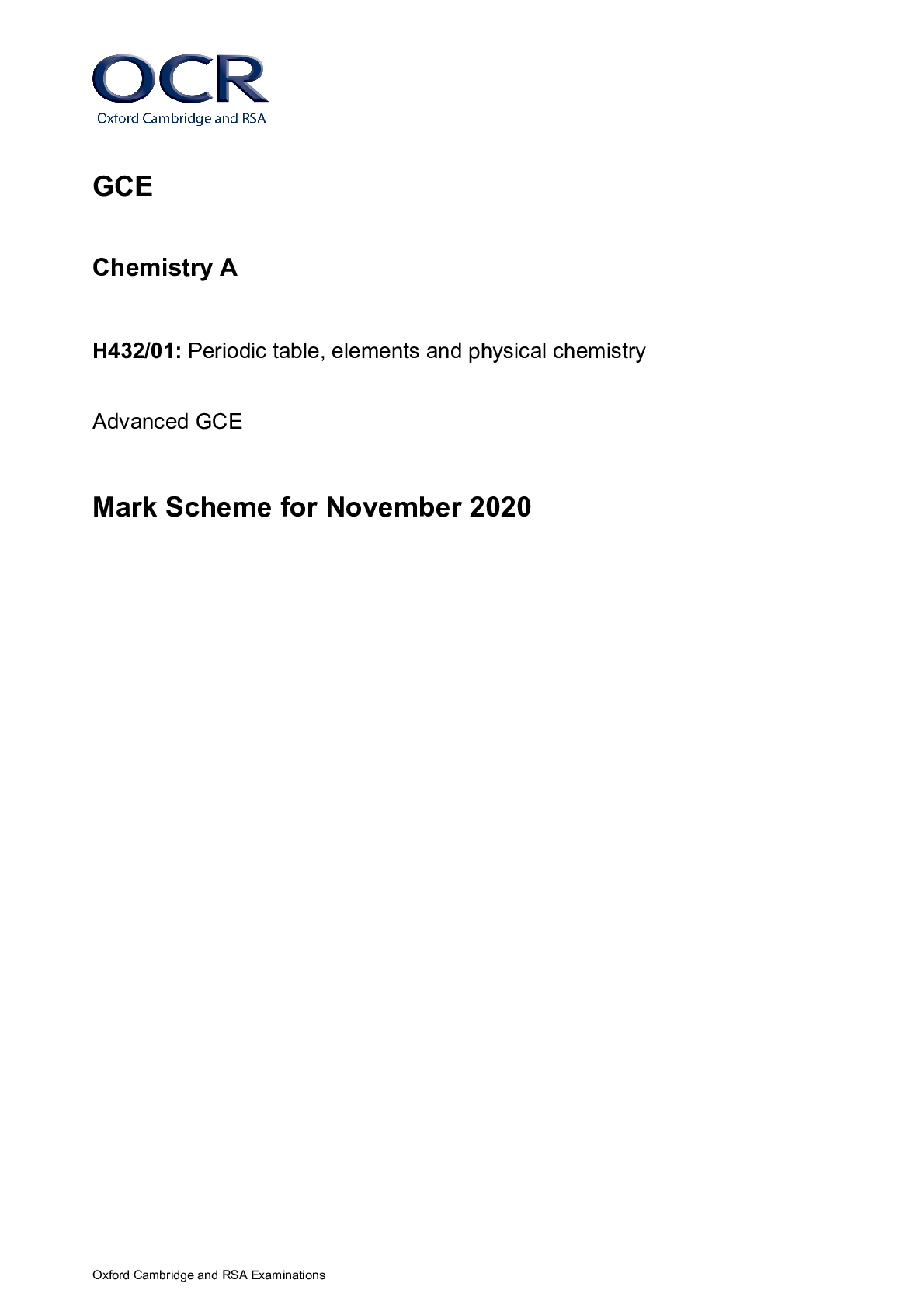
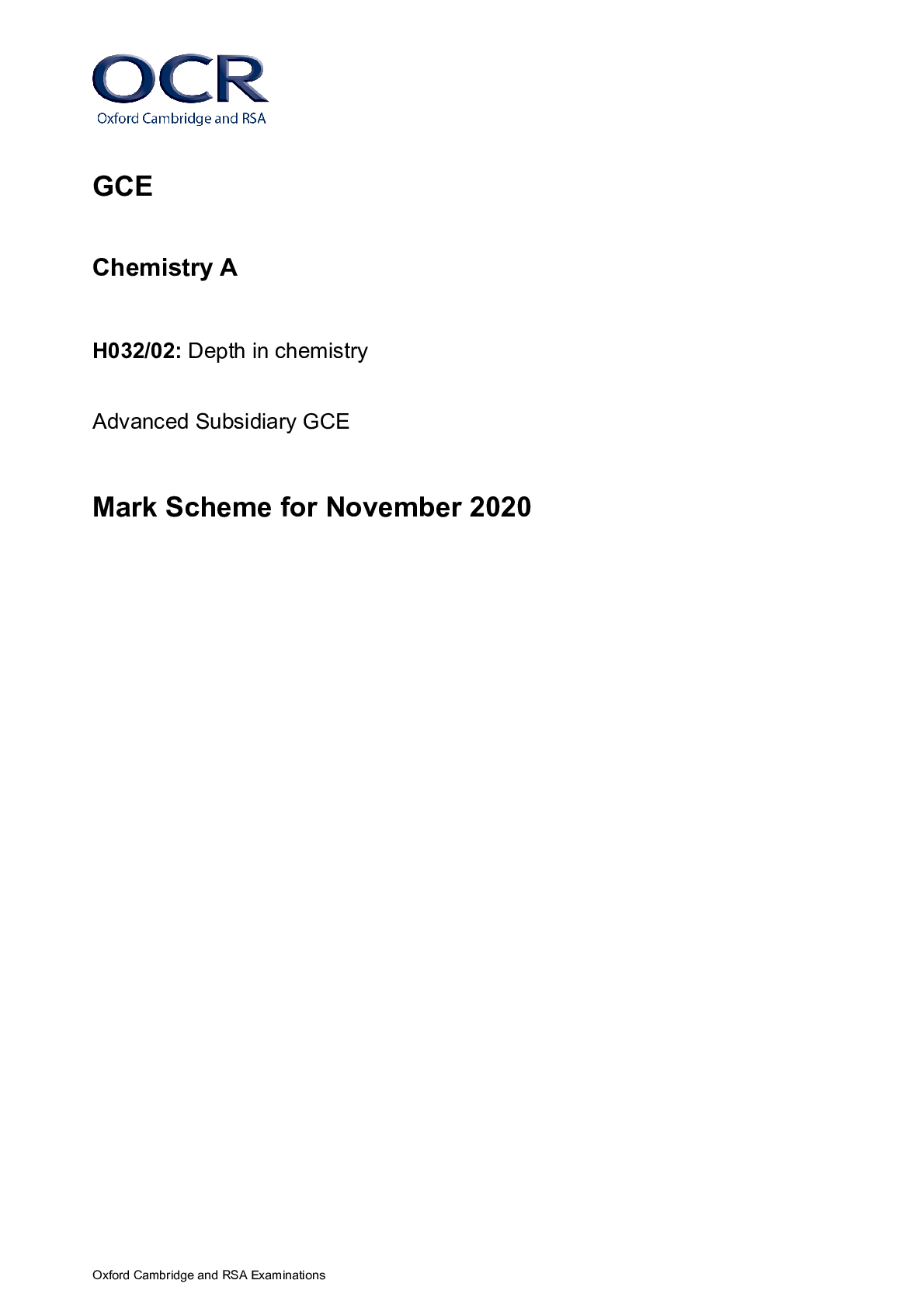

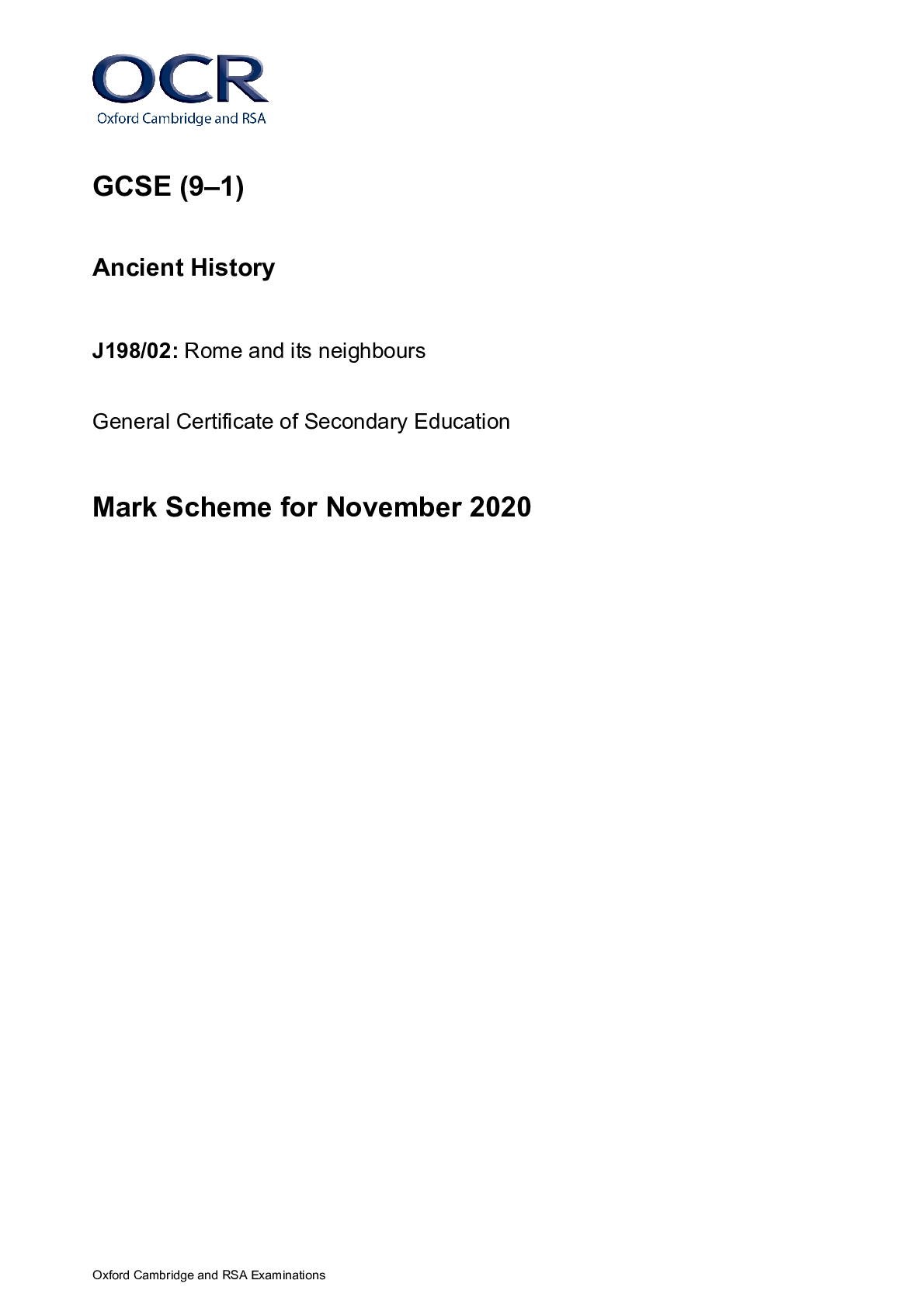




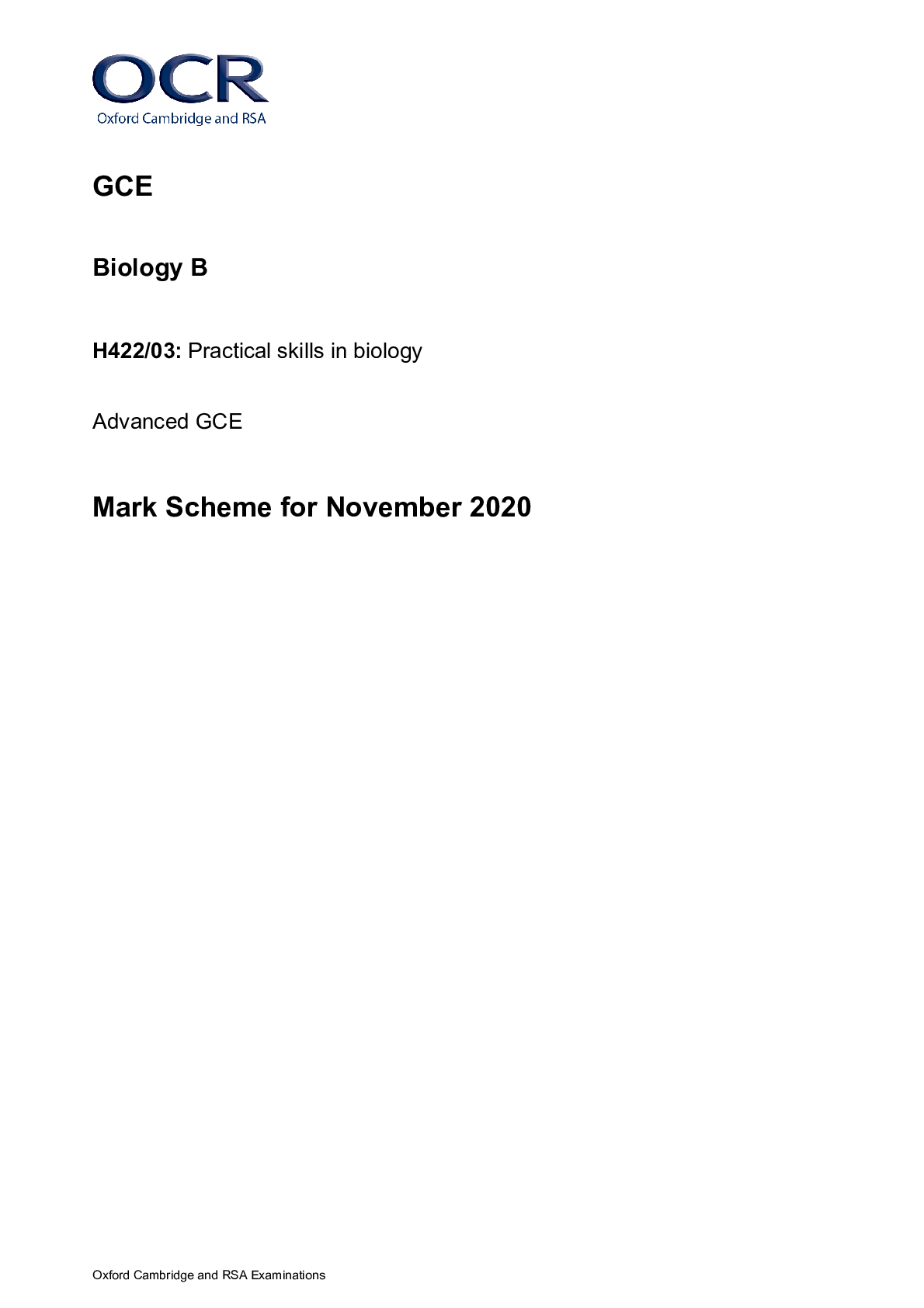

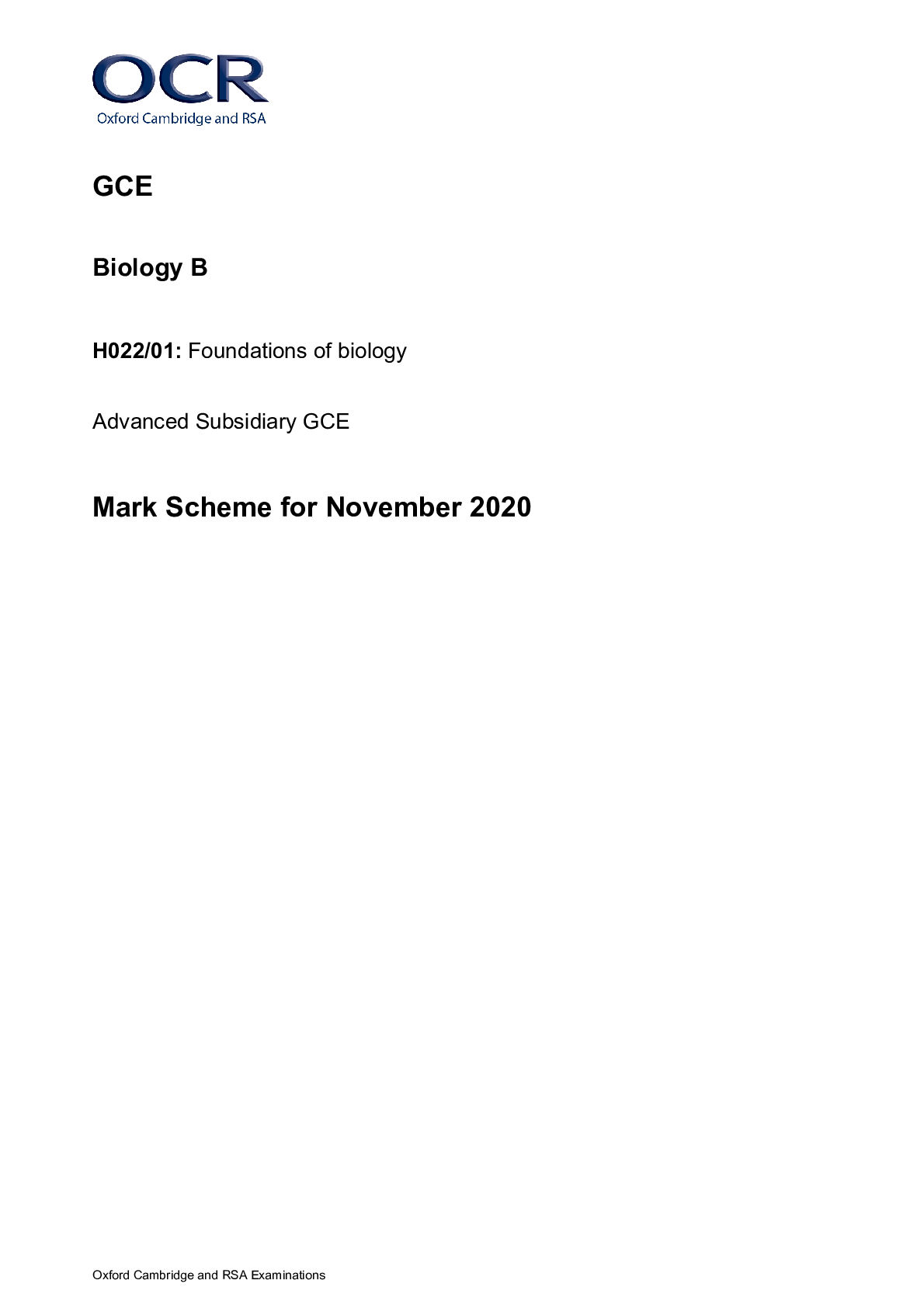

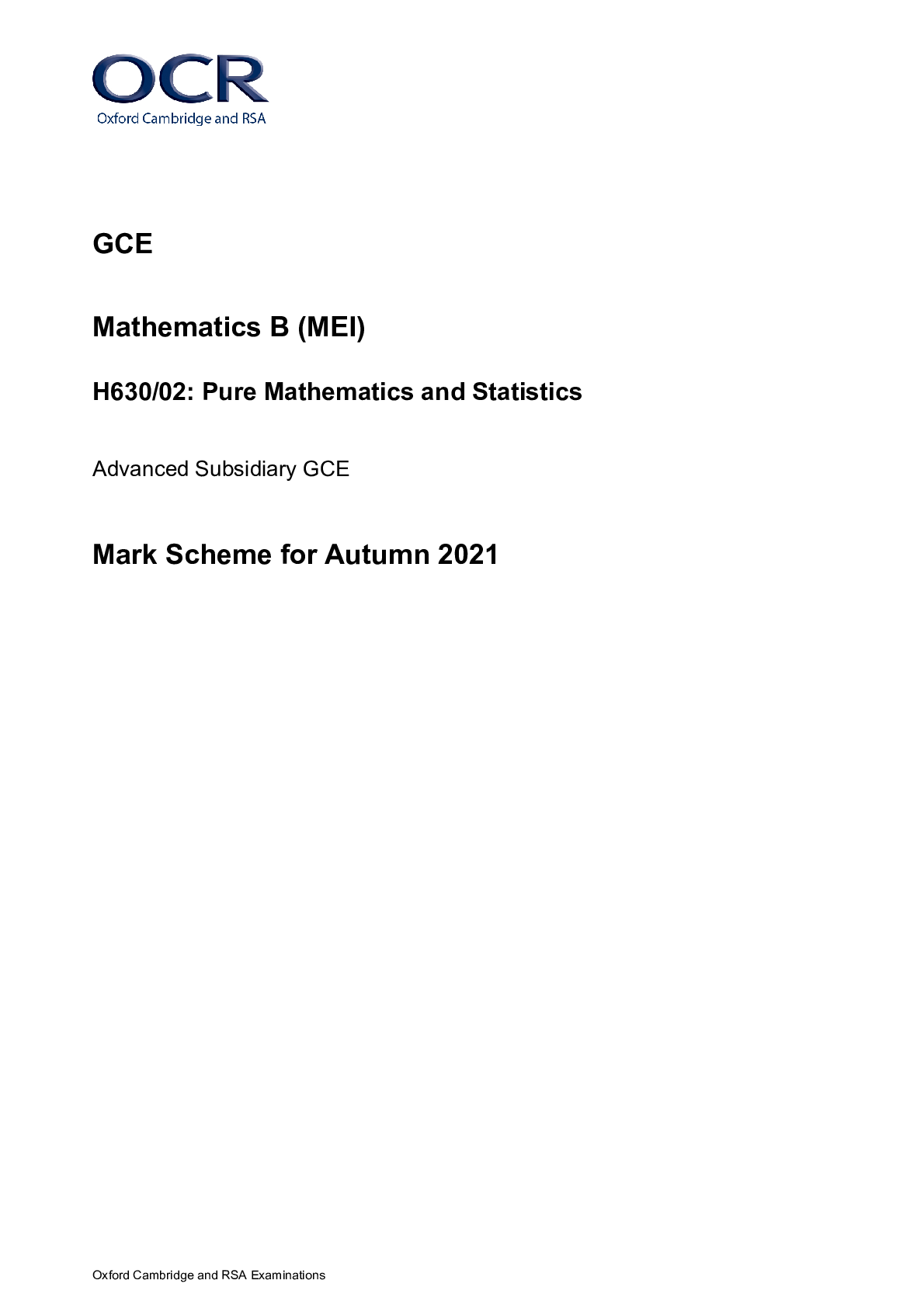


.png)
H630-02 Pure Mathematics and Statistics Advanced Subsidiary GCE Mark Scheme for Autumn 2021.png)




